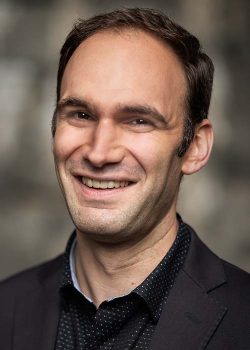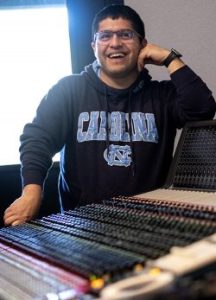With IDEAs in Action courses, faculty give students immersive experiences, hands-on training and ways to make new connections.

How can I help my students see that what they do as classical violinists is already aligned with the University’s new approach to educating undergraduates? Nicholas DiEugenio asked himself.
The answer, the associate professor of music found, was to ask students to choose and perform one piece of solo-violin music written in the past 10 years. “That prompt could sound easy or obvious, but for students who had primarily engaged with music written 150 to 300 years ago, it was an aha! moment,” DiEugenio said. The students introduced each other to music of composers identifying as female, South Asian, Black, Latino, Asian and Asian American.
“They were also able to hear, feel and see connections between these various voices and the other ‘traditional’ voices like Bach’s or Beethoven’s that they already knew,” he said.
That experience was a foretaste of the learning that the music department in the College of Arts and Sciences offers in a revamped curriculum structured on the IDEAs in Action curriculum that Carolina launched in fall 2022.
The video below shows part of a concert in which violin students and DiEugenio explored folk influences in music written for two violins in the 20th and 21st centuries. Kenan Scholars Ayman Bejjani (violin) and Shannon Chen (piano) play the pop-inspired work “Olmsted” by Robert Honstein.
Press the play button above to play the video.
A new framework
IDEAs in Action helps students think critically, work collaboratively and communicate persuasively. It emphasizes hands-on experiences and opportunities for practice and reflection in academic disciplines and prepares graduates to contribute in a fast-changing world.
Under that framework, departments across the College created courses and academic tracks to help students prepare for the rest of their lives by, in IDEAs in Action language:
- Composing, designing, building, presenting or performing a work that is the result of immersion in a creative process using appropriate media, tools and techniques.
- Explaining the roles and influences of creativity, technologies, materials and design processes in the creation of knowledge, expression and effective solutions.
- Evaluating their own and others’ creative work to demonstrate how critique creates value in creative domains.
The IDEAs curriculum begins with first-year foundation courses for exploring the sciences, arts and humanities. Second-year courses offer an array of ideas across the liberal arts. In year-three courses, students conduct original research, work as interns, volunteer, study abroad, create art and more. They attend performances, arts exhibits, lectures and workshops. Students choose an academic major after taking required courses and electives and consulting with academic advisers.
Here’s a look at some of the ways the music department’s adoption of the new curriculum has students and faculty excited.
Cross-pollination
The department redesigned its curriculum so that students can study and perform in musical genres that were already in flux. DiEugenio, one of many faculty members involved in the redesign, calls the curriculum a cross-pollination among traditionally disparate genres that “makes room for a broader diversity of voices within our majors and across the music we perform and teach.”

“How cool is it for a violinist to practice a Bach gigue next to a fiddler one room over who is spinning an old-time reel?” he said. “The curriculum excites me, not because of anything that it is ‘manufacturing,’ but because it reflects the inclusivity and natural overlapping already happening in the music world.”
“The full faculty was invested in the redesign,” said professor and Department Chair David Garcia, who led the effort. They listened to undergraduate music majors and graduate students, talked with colleagues at other top universities about what they viewed as important in their curriculum transformation and reviewed scholarship on reconceptualizing the study of music. Their decisions came amidst a bigger conversation about what is considered necessary knowledge for students.

Answering that bigger question helped faculty plan and strengthen what they were already doing, then successfully implement the curriculum. “It’s like the cart leading the horse in a way, but in the end, we’re here,” Garcia said. “Everything is balanced out. The curriculum reflects what we do, and what we do reflects the curriculum.”
Violinist Siana Wong is Exhibit A of how the curriculum allows students to move among musical genres. The junior biology and music major from Greensboro, North Carolina, and first-chair violinist in the UNC Symphony learned that she could play in the department’s Baroque Ensemble. “I’ve always loved baroque music. I didn’t know that UNC had a Baroque ensemble or that you could actually play on Baroque instruments. It was a good way for me to expand.”
She then stepped outside of classical music to join Charanga Carolina, an ensemble that plays music with Afro-Cuban roots. “A lot of the music relies heavily on rhythmic integrity, so having to play with such preciseness with everyone in the group was definitely a challenge. It made me open my ears and listen more closely to what was around me, which is so important for all types of music.”
In the video below, Charanga Carolina plays its spring 2022 concert.
Press the play button above to play the video.
Newer genres, new ensembles
A new Popular Music area of study includes hip-hop and beat-making classes created about 10 years ago by Mark Katz, John P. Barker Distinguished Professor of Music. Survey and performance courses in jazz, bluegrass, rock, country and world music round out the Popular Music area. Other areas on which music majors can focus are composition, jazz, music education and musicology. Most music majors also take lessons in an instrument or voice and perform in the department’s more than 30 ensembles.

Repertories that examine histories and performance of popular, folk and world music such as Javanese gamelan music now have a place at the core of degree programs, said Garcia. “We’re continuing our instruction in Western classical music and opera and jazz and adding pathways for students to focus on other repertories that we have already been teaching in music ensembles like in hip-hop, bluegrass and Latin music.”
Maya Shipman, aka Suzi Analogue, a teaching assistant professor, said the curriculum’s focus on hands-on experience brings great value for students, empowering them to create their own compositions.
She teaches the Hip-Hop Ensemble class, created under the new curriculum. It’s Carolina’s first performance group to explore musical techniques based on hip-hop’s cultural traditions and global influence. Open to undergraduate and graduate students, the course covers performance styles of musicians and live production teams.
In Hill Hall’s Beat Lab, ensemble members work on mix boards and instruments — a Moog synthesizer, keytar, bass guitar, drum machine and keyboard. Others sing and rap. On a November night, they prepared for a livestream rehearsal, heads bobbing as the “Wakanda Forever” soundtrack played. They tested equipment, checked sound loops and warmed up on instruments.
Wearing heart-shaped glasses and leopard-print clogs, Shipman, who also teaches two sections of Beat Making Lab, offered feedback before the students recorded a test track of their original “Find Your Soul,” complete with a sample from Carolina’s alma mater “Hark the Sound.”
“It’s also important that students understand the cultural origins for the music that interests them. That’s the basis of my teaching, to explain and connect the dots of the culture, then turn it into something tangible that inspires students and aligns with the curriculum and ideas that the University is tapping into,” said Shipman.
Just prior to planning for the new curriculum, the department formed the Carolina Bluegrass Band. Foundational classes on country music and bluegrass created by professor Jocelyn Neal set the stage for introducing bluegrass and other music genres.
Hands-on music production

(Jon Gardiner/UNC-Chapel Hill)
The new curriculum adds more ways to train students in music production, including courses taught by working professionals like Pablo Vega, a composer, audio engineer and 2008 graduate of the department who owns and runs a recording studio in Durham called The Workshop. The new courses blend lectures on music history and technology with hands-on recording sessions and visits to professional studios.
“The course material piques the interest of students from all walks of life,” said Vega, who has composed and scored music for over 20 video games, documentaries, films and TV shows. “I don’t remember my music classes at Carolina being as diverse as the classes I’ve taught in the past two years.
“It warms my heart to see the department offering courses that attract minorities. As a native-born Peruvian and the only student of Latinx heritage in my graduating class in the music department, I’m happy to see so many diverse faces.”
By Scott Jared, The Well
